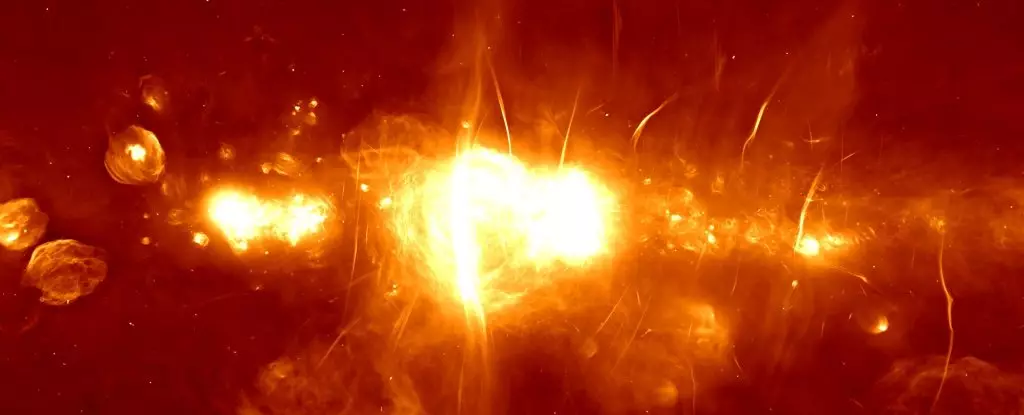At the very core of our Milky Way lies a chaotic yet magnificent structure known as the Central Molecular Zone (CMZ). This region brims with interstellar material, forming a complex web of dust and gas that continually shifts and evolves around the supermassive black hole at the galactic center. Recently, a groundbreaking discovery has emerged from this tumultuous environment, revealing a new type of gaseous structure—filaments that resemble cosmic tornadoes. Led by astronomer Kai Yang from Shanghai Jiao Tong University, research into these filaments sheds light on the intricate and often violent processes that govern the dynamics of our galaxy’s heart.
Distinctive Filaments: A New Breed of Cosmic Features
Previously identified filaments have encircled the galactic center, but the newly discovered structures stand apart. These long, narrow filaments appear to be spatially disconnected from star-forming regions, challenging the existing paradigms of galactic material distribution. The team used the advanced capabilities of the Atacama Large Millimeter/submillimeter Array (ALMA) in Chile to capture high-resolution images, unveiling these remarkable formations, dubbed “slim filaments.” Their unexpected properties not only contribute to our understanding of the CMZ but also raise questions about the mechanisms through which gas disperses in such a turbulent environment.
As they investigated these slim filaments, scientists uncovered that they are not merely a collection of gas; instead, they are dynamic entities rich in complex organic molecules such as cyclopropenylidene, formaldehyde, and methanol. The sophisticated chemistry within these filaments suggests an intricate interplay of physical processes, potentially reprogramming our understanding of material evolution in space. The velocity distribution of the molecules within these filaments diverges from that of other known gaseous structures, indicating that their pressure dynamics are influenced primarily by turbulent forces.
The Role of Turbulence: A Cosmic Choreography
The CMZ is not just a static collection of gaseous matter, but instead a vibrant arena exhibiting constant change. With clouds of gas colliding at staggering speeds—up to 100 kilometers per second—it is a highly dynamic environment characterized by turbulence and shock waves. This relentless motion leads to cycles of formation and dissolution, resulting in a tumultuous landscape where new structures are born from chaos.
The slim filaments appear to be a product of this turbulence. Researchers hypothesize that shock waves, born from collisions within the CMZ, act as catalysts for the birth of these filaments. By compressing and heating gas, these shock events can liberate complex molecules, transitioning them into the gaseous phase before allowing them to condense back into dust. This cycle not only perpetuates the clouds of material in the CMZ but also facilitates the redistribution of molecular constituents throughout the galaxy.
Cosmic Tornadoes: Efficiencies in Material Circulation
Imagining the slim filaments as cosmic tornadoes opens a fascinating perspective on material movement within the CMZ. Much like terrestrial tornadoes, which efficiently arrange dust and debris, these cosmic structures may serve to disseminate gases across vast regions. Such a role is vital for the ecological balance of the galaxy, enabling the recycling of materials essential for star formation and other galactic processes.
Interestingly, Yang and his colleagues suggest that the abundance of slim filaments could elucidate the high recycling rate observed in the CMZ. This concept transforms our understanding of how the galaxy manages its resources, showcasing an intricate dance of birth, decay, and rebirth amid the cosmic backdrop. In essence, these slim filaments can be viewed as conduits of chaos that facilitate the orderly distribution of gas, providing critical ingredients for future stars and planetary systems.
Expanding Our Astronomical Horizon
The discovery of these slim filaments is a testament to the advancements in observational astronomy and the evolving landscape of scientific inquiry. With powerful tools like ALMA, astronomers can peer into the depths of stellar nurseries and their chaotic surroundings, bringing to light phenomena once deemed too elusive to understand. As researchers explore the complexities of the CMZ further, our knowledge of galactic dynamics will undoubtedly deepen, revealing more of the stunning intricacies woven into the fabric of our universe.
In turning our gaze towards these cosmic tornadoes, we are reminded that within chaos lies a remarkable order—a structure to the madness that fuels star formation and defines the very essence of our galactic home. Each new filament discovered adds a note to the grand symphony of celestial phenomena, enriching our understanding of the cosmos and our place within it.


Leave a Reply